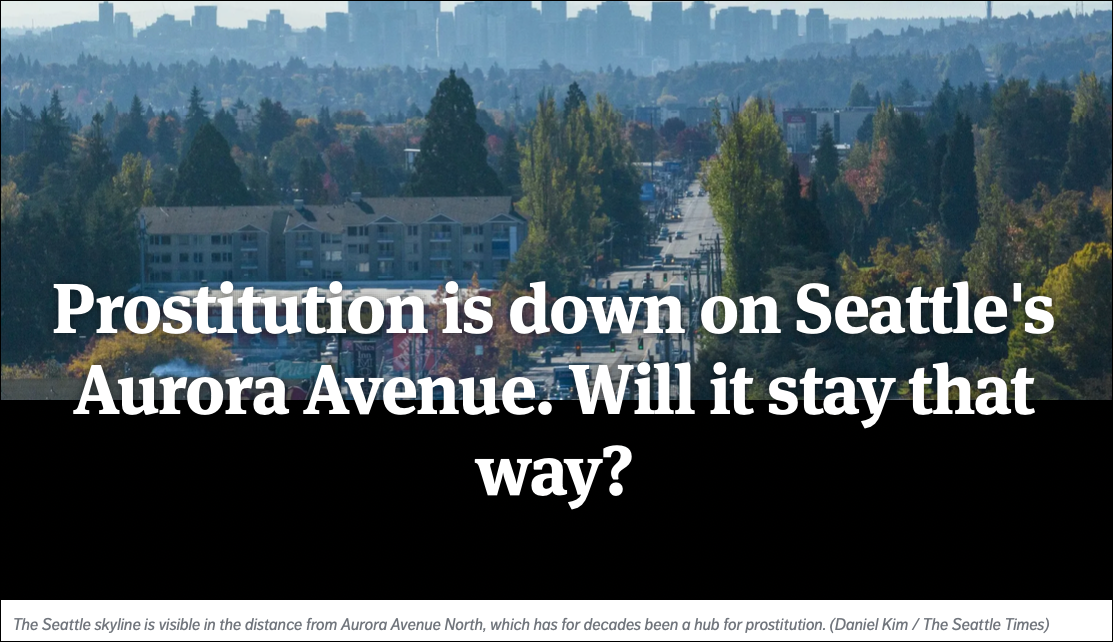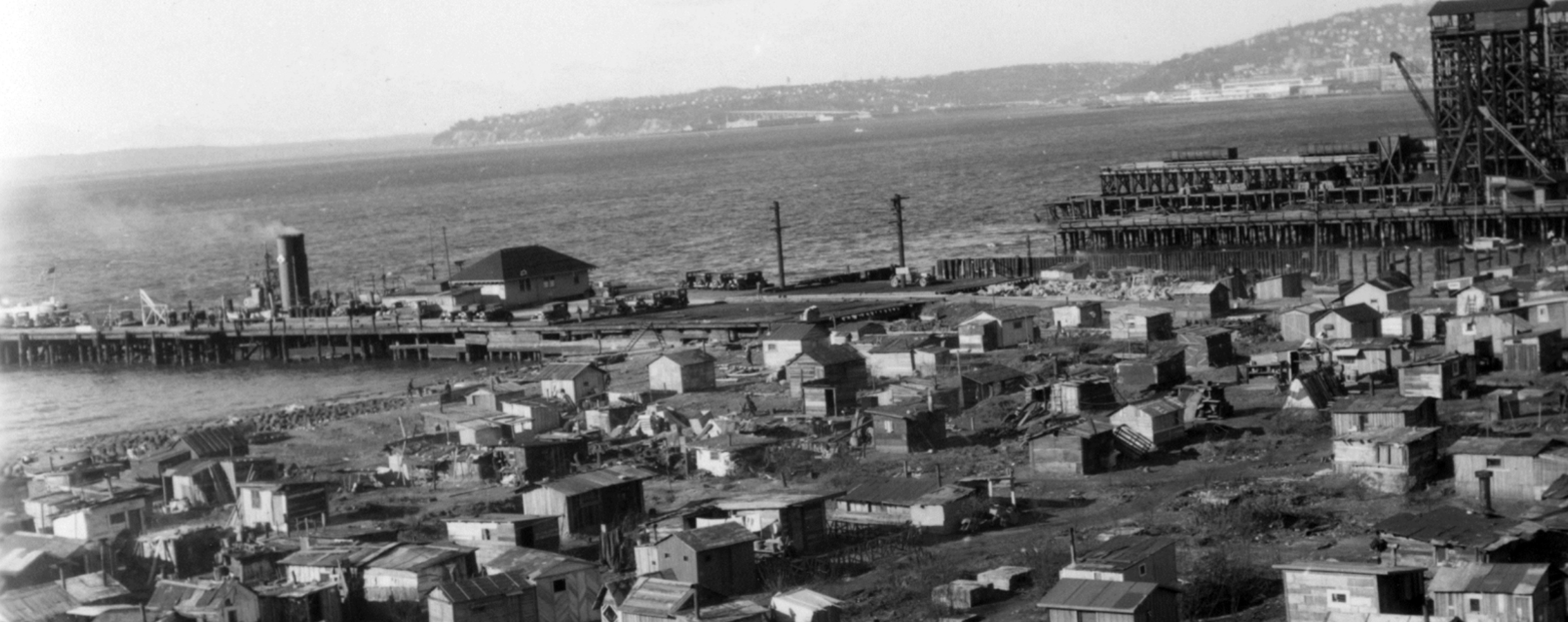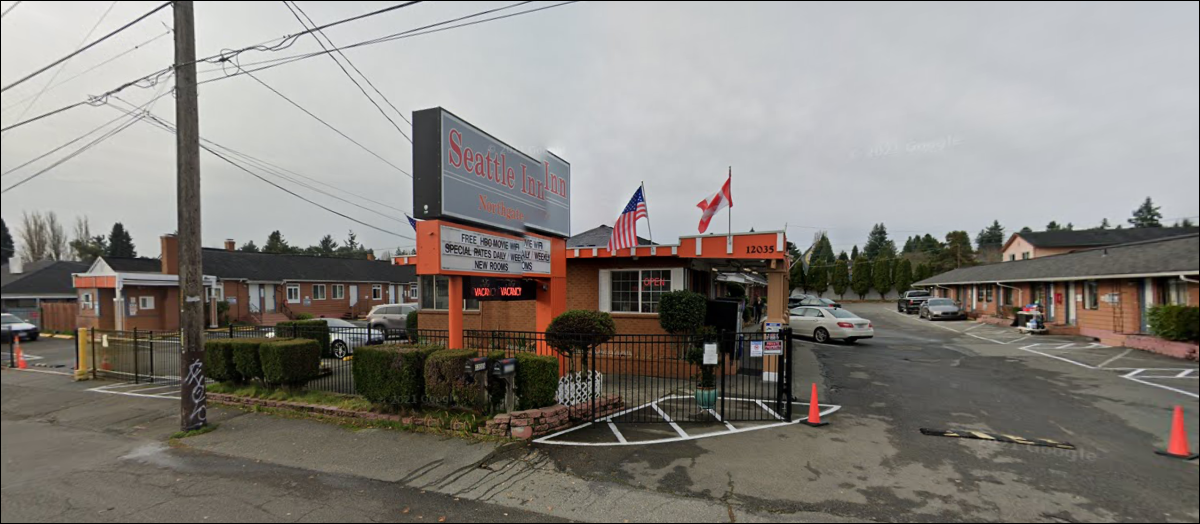There was a piece in The Seattle Times recently, averring that prostitution has declined on Seattle’s Aurora Avenue. It caught my eye because, not only do I have a condo out that way, but recent experience has me talking to some of the women who escaped — who survived — serial killer Robert Hansen. These women actively engaged in sex work. One key takeaway from these women: Society doesn’t want to see it. By “it,” I mean they don’t want to see scantily clad women luring men into pay-for-sex transactions. Seems self-evident.

But sex work isn’t called the world’s oldest profession for nothing. Without customers, the ladies of the night would simply disappear. The men, many of them married, keep coming back for more.
The sordid truth is that street prostitutes congregate in every city of size, usually along a corridor known as “the track.” The men always seem to know where the track is and what goes on there. I’ll never forget the time when my then-wife and I were driving through the town of Montpellier, in southern France. I’d never been there in my life. But I remarked to her, “Hey, they got a lot of hookers here.” She asked me, “Where?” That’s when I confirmed it: these women were dressed for men’s eyes only.
At any rate, most cities tolerate sex trade loitering — until they don’t. Sometimes the tide turns the other way. In Seattle, the city council changed the prostitution loitering law in 2020, such that loitering on the track is no longer illegal. And the cops don’t like it.
“You’ve legalized it. Prostitution loiter isn’t illegal, so they can walk up and down the street all day long.”
SPD Lt. Joe Osborne
“We don’t have any power to question them.”
SPD Captain Lori Aagard, Seattle’s North Precinct
Too Hot
Talk to any woman who’s been a sex worker, however, and you’ll get a different perspective. A prized location — be it city or street corner — inevitably becomes “too hot.” The cops start making arrests. Lots of arrests. That means these women end up in the criminal justice system. They’re not working. Can’t work. Time to move on. Find another city. Follow the money. In that sense, sex workers who ply the track are essentially homeless. Or serially homeless. In Seattle they resolved things by simply shutting down the two motels where the sex trade was centered. Categorized them as “chronic nuisance properties.” Bang. Over. Done.
See The Homeless?
Homeless. That, too, is a word packed with complex meanings. Not usually associated with sex work, it’s mostly a bad connotation, with visions of filth and rampant criminality. And, just like sex workers, society at large doesn’t want to see the unhoused. Homeless people are considered a nuisance. They too need to move along (although they inevitably show up nearby). Twenty-first century Seattleite’s might, however, be surprised to learn there’s a historical exemplar of people not wanting to see it.

Seattle’s Hooverville was built along the tide flats. Its occupants used any material they could find to build ramshackle dwellings.[1] The cause, of course, was the Great Depression that started in 1929. The name of this shanty village — there were several — came from the man who was President during this time. His name was Herbert Hoover. It didn’t take long for Americans to tire of Hoover. He was replaced by FDR (Franklin Delano Roosevelt). It was FDR who promulgated a series of dramatic safety measures, like Social Security and bank regulations. Safety measures, by the way, that Hoover’s successors in the Republican Party have hated ever since. But I digress.
Several attempts were made to get rid of the shack towns during the 1930s. City officials saw them as a health problem and a nuisance. Finally, in 1941, a shack elimination program began and the shack towns were systematically eliminated.
City of Seattle, Hoovervilles in Seattle
Same But Different
There are, to be sure, differences to be found among these examples. Contemporary tent encampments are driven by a different set of circumstances.[2] Instead of the Great Depression, in 2023 we have a dearth of affordable housing, a pandemic that wracked households economically and a lack of health care and addiction treatment. Taking a closer look at this cluster, researchers in Seattle made some sobering findings.
First, researchers Gregg Colburn and Clayton Page Aldern found that people sleeping on the street are only a subset of the unhoused, accounting for 30 percent of the homeless cases in King County, while the chronic unsheltered population make up less than 17 percent of total cases. They also found that chronic homelessness is both a cause and consequence of drug use and mental health issues.
One of the biggest contributors to homelessness, Colburn and Aldern find, is the lack of affordable housing combined with high interest rates that drive down availability.
Cities with higher rents and lower rental-vacancy rates (i.e., tighter housing markets) see higher per capita rates of homelessness.
Colburn & Aldern, “Homelessness is a Housing Problem”
On a personal note, I recently commented to a realtor that I didn’t feel that sorry for people complaining about current interest rates at, say, 7%. When I bought my condo, interest rates were hovering around 12%. We got it for 11%. The realtor gently reminded me that my condo cost $89,000 in 1980. The current price of a comparable dwelling is considerably more than that. There would be, in fact, a significant difference in monthly payments. I stand corrected.
See The Trade Off?
Tackling the sex trade surfaces a different set of problems. Decades ago sex work was centered in brothels. Cities didn’t like that (See? Doesn’t that sound familiar?), so they shut down the brothels. Which, of course, forced sex work into the streets. But with that came a sociological shift. No longer were madams at the center of sex work. The pimps took over.
“It’s always made me so angry that these guys are buying expensive cars and jewelry and things like that — and are playing video games all day — while screaming at you while you’re the one out on the street, in the cold. He’s still the one in control, and it’s infuriating.”
SPD Undercover Vice Detective

The other, not so hidden secret of the sex trade is that youth is an ever precious commodity. Everywhere you go, young sex workers are more the rule than the exception. I vividly remember the teen in Chañaral, Chile, soliciting along the Pan American highway in roller skates. It was a “what the hell” moment, but it’s nothing new.
During the 1900’s, a New York City survey found that 75% of prostitutes were between the ages of 15 and 25; three-eights of them were 20 and under. So those who decry trafficking are on the right track. Except… We also know that many teenaged sex workers end up on the street because they are runaways and castaways, who have no tangible skills and no viable means of support. The Washington State legislature has explicitly recognized this relationship:
“The legislature finds that juveniles involved in the commercial sex trade are sexually exploited and that they face extreme threats to their physical and emotional well-being. In order to help them break out of the isolation, fear, and danger of the commercial sex trade and to assist them in their recovery from the resulting mental and physical harm, [they need] the development of skills that will allow them to become independent and achieve long-term security” [2009 c 252 § 1.]
Sounds Nice
Sounds nice. In theory.
In practice, it’s more difficult to achieve. As my talks with former sex workers indicate, once these women enter “the life” and start playing “the game,” they have joined an alternate universe. They learn to hate the cops and trust their pimps. Society is able to “move them along” with impunity. To make it someone else’s problem. Which, of course, only means that “someone else’s” city will move them along as well. Hence, the capacity to deliver the services that might change a teenage sex worker’s direction in life… can go unused or unavailable. Or simply wasted.
Final Words
Sex work and homelessness have more in common than we’d prefer to think. I’d like to see a society that cares for the “least of these.” Not hypocritally so, but honestly so. Because moving it along doesn’t work. Never has. Never will. I guess the alternative costs too much or something. And, no, I don’t have all the answers. But it’s always best to start with the highest possible understanding of the problem. For most of us, unfortunately, it seems better to shake our fists and complain to the gods of our selfishness.
[1] Leslie Erb’s “Seattle’s Hooverville (1935),” contains a more nuanced look at the shanties. “The first shanty I visited in Hooverville was a surprise,” Erb writes. “It was a little, green two-roomed shack, with window flower boxes neatly painted. The owner, a man of about fifty, seemingly clean, invited me into his home. I noticed that the walls were nicely papered; the floors were laid with linoleum, his bed was covered with a clean, white spread; his suit and overcoat, neatly folded, were on hangers.”
[2] The contemporary unhoused person is, in contrast, geared toward a speedy escape. Knowing there will be a sweep at any moment, some keep their possessions to a minimum. The AP interviewed a woman who told them, “Everything that I own can fit on my wagon.” Associated Press, Nov. 28, 2023, Cities crack down on homeless encampments
Copyright Leland E. Hale (2023). All rights reserved.

Purchase Butcher, Baker
Order my latest book, “What Happened In Craig,” HERE and HERE. True crime from Epicenter Press about Alaska’s Worst Unsolved Mass Murder.
